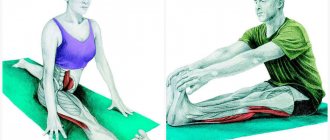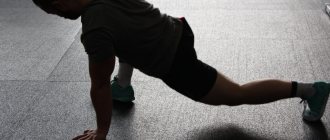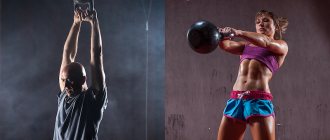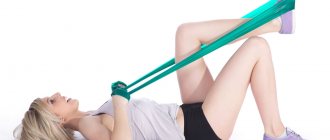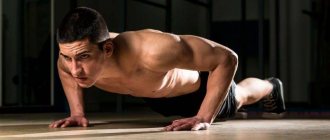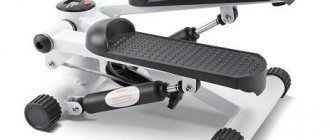When working to improve and maintain flexibility and, in particular, depth of inhalation and exhalation, practitioners often become overly fixated on stretching exercises. In the popular belief, in order to inhale deeply, you need to “stretch - lengthen - the respiratory muscles” in the manner of stretching rubber or fabric. This approach does not take into account at least two important facts. 1) Muscles are not an object static in their properties (like rubber), but living tissue that changes depending on the conditions, states of the body and the tasks it performs; you don’t need to lengthen them, but take care of their health and functionality. 2) In addition to muscles, flexibility is also influenced by other skeletal, or more precisely, fascial elements: joints, ligaments, tendons. So the level of flexibility is determined by a combination of muscle plasticity and mobility or mobility of fascial structures .
Strictly speaking, muscles have several different elastic properties: extensibility as the ability to lengthen under the influence of a load, elasticity as the ability to return to its original state after the load is removed, and plasticity as the ability to maintain the achieved length without changing tension. Stretching exercises improve the extensibility and flexibility of muscles and also promote muscle relaxation. This to some extent improves the condition of the articular-ligamentous apparatus, reducing tension in the surrounding muscles; gentle stretches also have a positive effect on the fascia itself, but they cannot completely solve the problem of limited mobility of fascial-skeletal structures. Therefore, it is important to approach flexibility and elasticity training in a comprehensive manner. Stretching exercises in this set of measures will be only one of the elements, albeit a really important one. Note here that stretches to promote fascial health should be done either in a comfort zone or with minimal discomfort.
Types of Flexibility
Flexibility is the ability to perform exercises that involve a large range of joint motion. An indicator of flexibility is the maximum range of movements. There are several types of flexibility.
Active Flexibility
Active flexibility is the maximum range of motion when working at a particular joint. To check how developed this ability is, you need to stand with your back to the gymnastics wall. From a standing position, you should raise your leg as high as possible and hold it in that position.
The check must be carried out without outside help; you can only rely on your own strength. Indicators of active flexibility give an idea of the extensibility of antagonist muscles that perform traction in opposite directions. They also characterize the strength of the protagonist muscles, which work in one direction.
Passive flexibility
Passive flexibility is the maximum amplitude of movements performed by a person using external influence. This could be equipment, weights, or help from a partner. To check the indicators of passive flexibility, you need to stand with your back to the gymnastics wall. While maintaining a standing position, you need to raise your leg as high as possible, supporting it with your hands.
Joint movements are limited by the degree of extensibility of muscle and connective tissue. High passive flexibility ensures good joint mobility. In this case, the amplitude of passive movements is always greater than the amplitude of active ones. The difference between these indicators is called flexibility reserve .
Overall flexibility
General flexibility represents the degree of mobility of all joints in the human body. It allows you to make movements with the greatest amplitude.
Special flexibility
Special flexibility determines the maximum mobility of specific joints. This indicator is taken into account when drawing up requirements for a particular type of sports activity.
Anatomical flexibility
The second name for this type of physical flexibility is maximum possible. It is determined by the structural features of the joints. In everyday life, a person uses a small part of anatomical mobility. But when playing sports, joint mobility can sometimes reach 95% of the maximum possible indicator.
The value of flexibility
In human daily life, the greatest role is played by the mobility of the spine, shoulders and hip. The effectiveness of mastering the technique of sports exercises depends on the degree of development of this ability. And exercises aimed at improving flexibility strengthen muscles, tendons and ligaments. Also, thanks to them, the coordination of the neuromuscular system is improved. The result is a reduced risk of injuries and sprains.
Poor quality of flexibility becomes a hindrance when trying to master the technique of performing sports exercises. Progress in the development of other physical abilities deteriorates. Exercises take longer than they should, and the muscles are constantly tense. Because of this, speed and strength soon disappear, giving way to fatigue. Often it is lack of flexibility that causes injuries to the musculoskeletal system.
Video lesson on physical education on the topic “A set of stretching exercises”
A set of useful stretching exercises.
Karmanov Alexander Sergeevich
Physical Culture
17.06.2020
Video lesson on physical education on the topic “A set of useful stretching exercises”
Link to video
https://vk.com/videos503730454?z=video-180272029_456239037%2Fpl_503730454_-2 performed by physical education teacher A.S. Karmanov, school No. 188
Why you need to stretch (5 Reasons)
1
The most banal reason is for beauty. Athletes know: without stretching, even well-trained muscles look “stiff” and the figure looks stocky. But even for those who are not going to exercise seriously, but rather for pleasure and health, stretching will help them become slimmer and more graceful.
2
Stretching will help maintain healthy joints. Cartilage and ligaments do not have a blood supply. The only way to bring them nutrition is through stretching exercises. By exercising regularly, we will maintain the mobility and youth of our joints and spine.
3
Stretching exercises improve coordination and strengthen joints. Makes ligaments more elastic. This will reduce the risk of injury if, for example, we slip and fall.
4
Stretching exercises perfectly improve mood, a person becomes more balanced and self-confident.
5
And stretching not only stretches muscles and ligaments, but also helps relieve muscle fatigue, pain and even nervous tension. Stretching is very useful for office workers who spend many hours in the same position at the computer.
10 EXERCISES FOR BACK FLEXIBILITY
- STANDING BACKBEND
What are the benefits: Makes the thoracic spine mobile, strengthens the deep back muscles and has a good effect on posture.
- SPHINX POSE
What are the benefits: Develops flexibility of the lower spine, promotes lung ventilation and relieves muscle tension.
- DEFLECTION IN THE BACK
What are the benefits: Improves mobility of the spine in the upper part, stretches the back muscles, relieves tension and pressure in the shoulders and chest.
- EXERCISE “SWIMMER”
What are the benefits: Develops back muscles, improves spinal flexibility, strengthens legs, develops balance and coordination of movements.
- CAT
What are the benefits: Relaxes the back muscles, improves the mobility of the spinal column, helps develop back flexibility.
- FOOT GRAB ON ALL FOURS
What are the benefits: Develops balance and coordination, improves back flexibility, has a calming effect.
- HALF BRIDGE POSE
What are the benefits: Strengthens the muscles of the back, buttocks and hips, stretches the spine, strengthens the pelvic floor muscles.
- TWIST IN DOWN FACING DOG POSITION
What are the benefits: Stretches the shoulders and back, strengthens the arms, relaxes the lower back.
- BACK TWIST
What are the benefits: This back flexibility exercise develops mobility of the spine, especially the lower part, helps develop back flexibility and strengthens the muscles.
- "ARC" LYING ON YOUR BACK
What are the benefits: This back flexibility exercise stretches the spine, improves its mobility, opens the shoulder region, and also relaxes the lower back.
Quality of flexibility
The mobility of the musculoskeletal system depends on several factors:
- Structures of joints: their shape, thickness of articular cartilage, length of articular surfaces. The presence of bony protrusions is also important.
- Degree of elasticity of soft tissues.
- The strength of the muscles that carry out movements in the joints.
The shape of the joints can be:
- spherical;
- ellipsoid;
- block-shaped;
- saddle-shaped;
- flat;
- cylindrical.
Ball joints (hip, shoulder) have maximum anatomical flexibility of the body. The saddle, planus, and trochlear joints are naturally the least mobile. Anatomical mobility is directly proportional to the length and curvature of the articular surfaces.
Of all the soft tissues of the musculoskeletal system, muscles have the greatest extensibility. Their length can increase by 30-50% of the original. Ligaments and tendons are much less elastic. But the elastic abilities of soft tissues increase due to high temperature, which ensures blood flow to them.
The first stage is warming up
To develop plasticity, it is very important to properly prepare your body for training - perform so-called warm-up exercises. These even include the usual one, don’t forget about this on the way to the gym - don’t waste time and speed up your step a little, it will be much easier to exercise during training.
At the gym, start with aerobics - your heart rate will increase, blood flow to your muscles will accelerate, your temperature will rise, and the overall benefits of stretching will increase significantly. Another great way to “warm up” is jogging, just always start at a very slow pace.
Ideally, you should perform warm-up exercises until light sweat appears; this sign signals that you can proceed to a more difficult stage.
Flexibility in children
Greater flexibility can be developed naturally up to 14-15 years of age. The dynamics of development are uneven and depend on the type of joints involved. The greatest improvement in the range of motion of the hip joints is observed at the ages of 7-8 and 11-13 years. Further, the process occurs at a stable pace, and from the age of 16, progress noticeably slows down.
The mobility of the joints of the spine and the rate of its natural growth differ in men and women. In girls aged 7-8, 10-11 and 12-14 years, this ability rapidly develops. Boys experience a natural increase in mobility at 7-11 and 14-15 years of age. At the age of 15 years in boys and 14 years in girls, stabilization and decreased flexibility of the spine are observed.
Small joints are characterized by faster development of mobility. The use of special exercises helps increase flexibility and maintain it at a high level. If you neglect them, then with the onset of adolescence, the mobility of all joints will begin to deteriorate.
At the same time, women's range of motion is on average 10% greater than that of men. The female body is characterized by greater joint mobility. But with the onset of old age, the flexibility of women and men is almost the same.
Exercises with a primary effect on the abdominal and back muscles
13. I. p. - sitting on the floor or bench. Issue: simultaneous or alternating swings with straight legs to the sides or crosswise, up and down. Options: imitation of cycling with leg movements; flexion and extension of the legs at the knee joint, pulling the heels towards the buttocks. For 20-30 seconds at a medium to fast pace.
14. I. p. - sitting on the floor or bench. Issue: circles with straight legs over a large amplitude with the legs positioned together and separately - inward and outward. Repeat 8-10 laps at an average pace.
15. I. p. - lying position. Issue: push your legs into a crouching position - bend over, then lie down again. Repeat 6-8 times.
16. I. p. - hanging on the bar with an overhand grip. Issue: raise straight legs, fixing the “angle” position and lower them into i. p. Options: alternately raising legs; raising your bent legs until your knees touch your chin. Repeat 4-8 times.
Sports and flexibility
To develop flexibility, the athlete needs to maintain regularity of exercises and maintain the same frequency of exercise.
The following sports help improve joint mobility:
- gymnastics (rhythmic and sports);
- stretching;
- acrobatics (free, on canvases);
- yoga.
Each of these techniques has its own advantages. Gymnastics is based on flexibility, so gymnasts devote a huge part of their time to working on this ability. Stretching is a set of special exercises aimed at stretching.
Acrobatics not only helps improve your flexibility, but also strengthens your muscles. Yoga involves developing the ability to maintain balance. At the same time as working on flexibility and endurance, proper breathing is honed, filling the blood with oxygen.
From a physical education perspective, flexibility is classified in the same way as in sports. But the goal of the exercise is to stretch the entire body, from the back to the lower extremities.
Development of leg flexibility.
Stretching the hip part of the legs.
The importance of flexibility in this part of the legs is difficult to overestimate. This way you will improve blood circulation, improve muscle elasticity and reduce the possibility of injury, form good posture, etc.
A set of exercises for stretching the hip part of the legs from the choreographer. These exercises will help you do the splits without any preparation. Suitable for all leg flexibility. It’s just that for some it will take more time, for others less.
You can see even more leg stretching exercises in the article “How to do the splits. Advice from ballerina Elizaveta Taranda"
Foot stretching.
Leg flexibility is not just about the hip part. Don't forget about your feet. After all, they support the whole body, maintain balance and help push off when walking or running. Therefore, lifting the foot is no less important quality than eversion of the legs.
Stretching the instep is very difficult, but it is necessary. This way you will not only get beautiful feet, but also prevent injuries and bruises.
This video presents a set of exercises for easy stretching of the feet, which does not require special preparation.
How to develop flexibility
The first and necessary stage of developing flexibility is for the athlete to perform warm-up exercises for 10-15 minutes. Cardio exercise is considered the ideal option.
The athlete will benefit from jumping rope, walking in place, running, and squats. They will increase body tone and ensure blood flow to the muscles. After this, you can proceed directly to flexibility exercises.
Methods for developing flexibility
There are two main ways to develop flexibility. The first is the repeated stretching method, the second is the static stretching method, which has several variations. The choice of method depends on how much flexibility needs to be trained.
Repeated stretch method
Based on the fact that repeating an exercise multiple times allows you to stretch your muscles more. In this case, the amplitude of movements should gradually increase. At the beginning of classes it will be small, but by 8-12 repetitions it should be brought to the maximum. Reducing the range of movements serves as the limit for the optimal number of repetitions.
Static stretch method
It is based on the dependence of the degree of stretching on its duration. You should relax and then do a flexibility exercise. After this, it is necessary to maintain the final position from 10 seconds to a couple of minutes. The exact time depends on the capabilities and experience of the person. Static exercises can be performed either alone or with a partner.
Active-static stretching method
It uses maximum tension on the antagonist muscles to stretch a specific muscle. This technique is recommended for those who do, for example, gymnastics. This sport involves certain types of active flexibility.
Stretching method with alternating tension and relaxation of muscles
Provides for the simultaneous contraction of antagonist muscles. Tissue elasticity increases due to a combination of autogenic inhibition before stretching and reciprocal inhibition during stretching.
Developing flexibility at any age
How to become flexible? This question worries thousands of girls all over the world, because good body contouring is needed not only by those who dance. It fills every movement with grace, your gait changes, and your well-being improves. And if you need to dance at a disco, you will feel more relaxed. To develop flexibility, you need to make an effort and set aside time to perform special stretching and flexibility exercises. We will tell you how to become the owner of these qualities.
Many people, and even those who play sports, do not understand why they should take the time to stretch. Firstly, it is necessary to maintain the skeleton, prevent scoliosis and other diseases. If your muscles are developed, they function better. Secondly, you will gradually begin to notice that daily household stress has become easier for you to bear. Third, since flexibility is the degree of movement of joints, you increase your range of motion. Fourthly, flexible people do not begin to feel constrained even with age.
Now you understand that body flexibility needs to be developed. And it is best to do this from an early age. Children are born very flexible, but over time they lose this quality. Therefore, try to maintain and develop body plasticity throughout your life. Don't forget about the concept of muscle memory: the sooner you start playing sports, the better your physical shape will be by the time you cross the retirement line. For those who have never picked up a barbell, it is almost impossible to pump up after 50.
Types of stretching.
- Static is a gentle stretching of the muscles, most suitable for beginners. The fixation time for one exercise is 20 seconds. Static stretching allows your muscles to relax and improves their flexibility. Best done after a full workout;
- Dynamic – performing practical exercises in combination with stretching. By performing dynamic exercises, you gradually stretch your muscles, increasing the amplitude and speed of movement. The benefits of dynamic stretching are improved blood flow in the muscles, adaptation to training. The fixation time for one exercise is 1-2 seconds. Best done before training.
Rules for the development of plasticity.
To begin with, it is important to understand which joints should be mobile and which should remain stable. Thus, the knee and elbow joints, as well as the lumbar and cervical spine, must be strong and stable. But the ankle, hip, shoulder and wrist joints, and thoracic spine need to be developed.
It is important to always remember that before you start doing flexibility exercises at home, you need to warm up your muscles. To do this, it is enough to do a classic warm-up, for example, perform side bends, rotations and swings of your arms, squats, etc.
